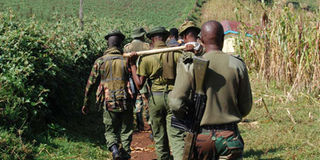A journalist's firsthand experience of Mau destruction

Kenya Forest Service rangers during a patrol inside the Maasai Mau Forest at Sebetet area on September 6, 2019. PHOTO | FRANCIS MUREITHI |NATION MEDIA GROUP
What you need to know:
- The forest's destruction is a thorny issue as it is ecologically and economically critical for Kenya and parts of East Africa.
- In addition, more than 10 million people, including members of the indigenous Ogiek community, depend on the rivers.
- A tour of the Mau is not a refreshing exploration of mother nature as the once beautiful and scenic landscape is depleted.
- Deforestation and widespread degradation are evident from the busy Narok-Bomet highway that overlooks the 400,000-hectare forest.
Anyone seeking to understand the extent of Maasai Mau Forest's destruction needs to prepare "physically and mentally" as the findings "drain you".
This is according to Chief Inspector Njoroge Mugo of the Kenya Forest Service (KFS) who took a journalist from the Nation on a tour.
With KFS rangers, the journalist went on a five-kilometre trek that took about three hours.
While describing the destruction that he saw, he speaks of a severely depleted forest that leaves one with feelings of "sadness, heartbreak and despair", and of a mission that is "not for everyone".

Kenya Forest Service rangers walk past a river that is drying up inside the Maasai Mau Forest during a patrol on September 6, 2019. PHOTO | FRANCIS MUREITHI | NATION MEDIA GROUP
THORNY ISSUE
The forest's destruction is a thorny issue as it is ecologically and economically critical for Kenya and parts of East Africa.
In addition, more than 10 million people, including members of the indigenous Ogiek community, depend on the rivers.
The government has tried before to evict illegal settles but challenges have included their claims of ownership, accusations against police on the group and political interference.
Meanwhile, coverage of the situation on the ground from the peripheries has proven insufficient and so have accounts from witnesses and statements from authorities as they often give scanty information.

Kenya Forest Service rangers during a patrol inside the Maasai Mau Forest at Sebetet area on September 6, 2019. PHOTO | FRANCIS MUREITHI |NATION MEDIA GROUP
EXTENSIVE DAMAGE
For anyone, a venture into just five kilometres of the forest would be akin to a tough endurance challenge.
The journey is not for everyone, least of all those who are unfit and who do not find tough terrains thrilling.
And as Mr Njoroge warned, the tour is not a refreshing exploration of mother nature as the once beautiful and scenic landscape is depleted.
Deforestation and widespread degradation are evident from the busy Narok-Bomet highway that overlooks the 400,000-hectare forest.
Some of the rivers in the Mau are muddy and drying up, with decaying logs floating on them. In addition, the beehive that Ogieks placed on some trees long ago are now a rare sighting.
Wild fruits are also difficult to find and gone are the soothing sounds of River Mara's waters as it snakes its way through deep valleys and rolling foothills.
Wildlife are a rare sighting but domestic dogs bark endlessly at chirping birds.
Smoke from timber houses also engulfed the forest and illegal community learning centres stood out like sore thumbs.
In addition, they lacked sanitation blocks, meaning the teachers and learners likely relieved themselves in the forest.

A view of the destruction inside Maasai Mau Forest as pictured on September 4, 2019. PHOTO | JOAN PERERUAN | NATION MEDIA GROUP
LAND CARTELS
The trek with the officers started at their makeshift camp christened Loliondo, adjacent to the controversial Sierra Leone area that has been heavily invaded by the illegal settlers.
The invaders have reduced the once beautiful forest into a noisy and messy area that resembles a mushrooming slum in a rural setting.
Some claim they own the land but their documents are not genuine, thanks to cartels.
Meanwhile, the man who dished out land in the Mau Forest Complex to firms and individuals, laying the foundation for the current problem, has defended his actions.
Mr Sammy Mwaita, who was then-commissioner of land, says he has no apologies to make.
He says he is open about his involvement in the land allocations and admits that alongside the poor and landless who received land for settlement, powerful people in the Moi government also benefited from the allocations.

Some of the houses who roofs the owners removed in readiness to leave Maasai Mau Forest, September 4, 2019. PHOTO | JOAN PERERUAN | NATION MEDIA GROUP
"SATAN"
During the tour, a group of about 50 KFS rangers closely monitored illegal settlers as they vacated the forest.
Their G3 rifles and machine guns inspired confidence that one would be safe but not that the forest would be restored.
But the sight of a remarkably tall indigenous tree in an isolated thicket was a source of hope.
Chief Inspector Mugo and the other officers were very friendly, patient and helpful, giving information about the area, wildlife and the forest cover.
“It pains me to see indigenous trees that were here even before Christ cut by illegal settlers,” a ranger as he pointed at a decomposing brown olive tree in the middle of potato farm with his fully loaded rifle.
Another said, “We want to execute the task as if the directives are from heaven. We must slay this Satan that has refused to leave Mau forest since 1990."
Cabbages, maize, peas and onions are among the crops that have been planted in the forest and the people also practice dairy farming.
“With this kind of farming in the middle of the forest, the remaining wildlife such as squirrels are afraid to mate,” said another ranger.
Another said, “This forest had wildlife but the human encroachment has forced them to migrate."





